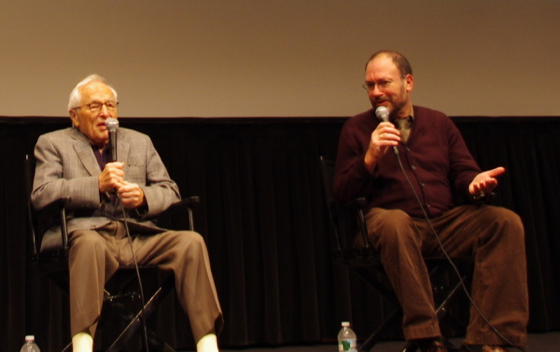
J Hoberman (right) moderates a Q&A with screenwriter Walter Bernstein (Image from filmlinc.com. Photo by Wildman / FSLC.)
Veteran Village Voice film critic J. Hoberman was laid off last Wednesday, a significant loss for the paper, which was the first mainstream paper to publish avant garde film criticism in the United States. This began with writer, organizer and artist Jonas Mekas’ “Movie Journal” in 1958, though even at the time of Hoberman’s dismissal, his position was exceptional. Up until Wednesday, Hoberman was the only critic at a major publication who regularly covered experimental cinema.
This is very bad news for the art community, as it means even less coverage from the Voice than it already receives. The paper has had no full-time art critic since Christian Viveros-Faune was canned in 2008, though he’s since returned as a contributor, along with Martha Schwendener. Hoberman reviewed events outside the beat of both Viveros-Faune and Schwendener, providing coverage of artists like Shana Moulton and Nick Hallett, and screenings at Light Industry and Anthology Film Archives.
Though Hoberman began his career writing about experimental film, he is also fluent in genre, cult, independent, and Hollywood realms, and he’s highly active in various levels of the local film community. One example of Hoberman’s unusual reach begins with a retrospective on Yiddish cinema which he co-curated at MoMA in 1991. From his research on the show Yiddish Film Between Two Worlds was born his definitive manual on Yiddish cinema, Bridge of Light; when the book came back into print in 2010, he introduced a screening of a 1930s Yiddish musical The Singing Blacksmith at Light Industries.
The more people we asked, the wider Hoberman’s influence. A well known local film curator who asked not to be identified told us that he was introduced to many new artists through Hoberman’s work, that would then later lead to shows. “For years, he has been a champion of works that were remarkable, but may have had few champions.” he said over the phone.
Famously, Hoberman’s first review at The Voice was of Jack Smith’s Flaming Creatures, which remains his favorite film. Ken Jacobs is also cited as a filmmaker who has many fans, but is much better appreciated for Hoberman’s criticism. “Even when Jim is writing about some huge Hollywood blockbuster,” the curator continued, “he’s coming at it with this perspective that cinema can be so many different things.”
Back in 2006, S.T. VanAirsdale of The Reeler wrote an in-depth piece on the state of The Voice post-2005, which opened with the line: “For everyone fretting about the changes sweeping the vaunted film section of the Village Voice, you can relax: Jim Hoberman is staying.” VanAirsdale went on to quote film critic and Pulitzer prize finalist Matt Zoller Seitz on the Voice’s value to independent film writing, due, in large part, to Hoberman:
Nobody comes close, not even The New York Times, because The New York Times won’t bust out some little off-the-wall, American independent film. They won’t run an 800-1,000-word feature on a filmmaker from Asia or Europe just because they think they’re interesting. The Voice has been traditionally the only game in town; they’re the guys who have been holding down the fort for eclectic filmgoing.
Since the merger, fired senior editor Dennis Lim told the Reeler that the Times editors requested that he reduce emphasis on small films. “It would be wonderful if Jim still gets to write about what he wants, but the section as a whole is being steered away from coverage of art house and specialized programming. That’s not an opinion but an empirical fact,” he stated.
Hoberman’s coverage is so important to independent film companies that some, such as Magnolia Films, had threatened to pull ads from the Voice if Hoberman were fired. No word on such movement yet, but last week Hoberman told Indiewire: “That could really happen…I’m certainly friendly enough with the distributors who handle the display ads for movies. I know this will be a concern for them.”
Artinfo’s Graham Fuller deems Hoberman “unquestionably the most influential American film critic of the last thirty years,” and Roger Ebert tweets him “a pillar of American film criticism.” There’s even a term for his followers- “Hobermanbots”- coined by spurned critic-enemy Armond White. For those unfamiliar with his work, film critic Glenn Kenny has compiled a list of top-ten Hoberman paragraphs, spanning 1977 to 2011.
Overall, though, the art and film community seems less disheartened with Hoberman’s future than with that of the Voice. Said the same well known anonymous film curator,
In another age in New York, every one in their twenties would have been regularly reading The Voice; it’s no longer that the general public is looking to it for what’s going on that week… Hoberman’s still here. He can write wherever he pleases, and his intellectual energy is totally undiminished. In that regard, there’s no loss.
Though his presence remains strong within the art community, the greatest loss is a link between experimental film and the general public. In addition to his books, contributions to Artforum, Film Comment, and the Virginia Quarterly Review, his teaching position at Cooper Union, and his lectures at NYU, let’s hope that Times keeps him on as a regular contributor.


Comments on this entry are closed.